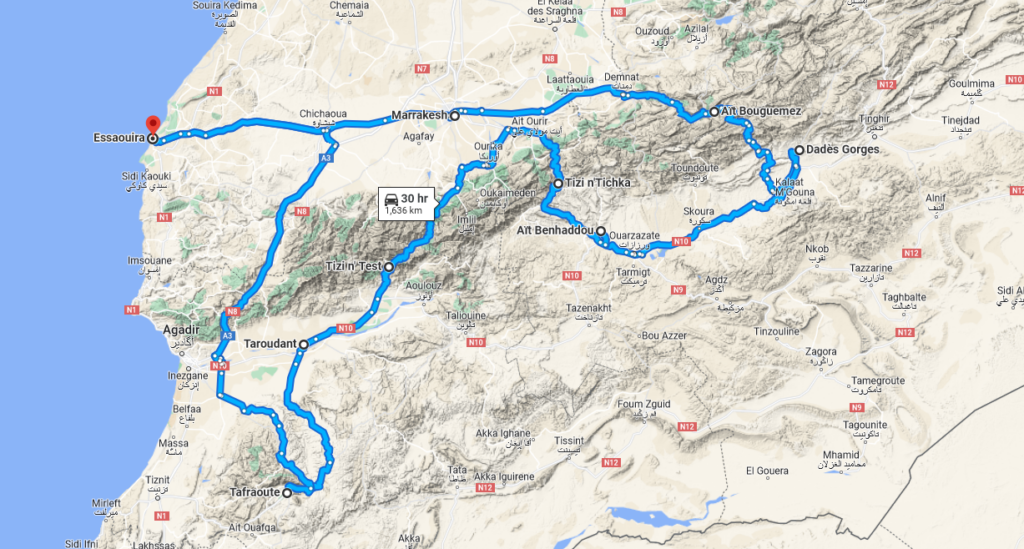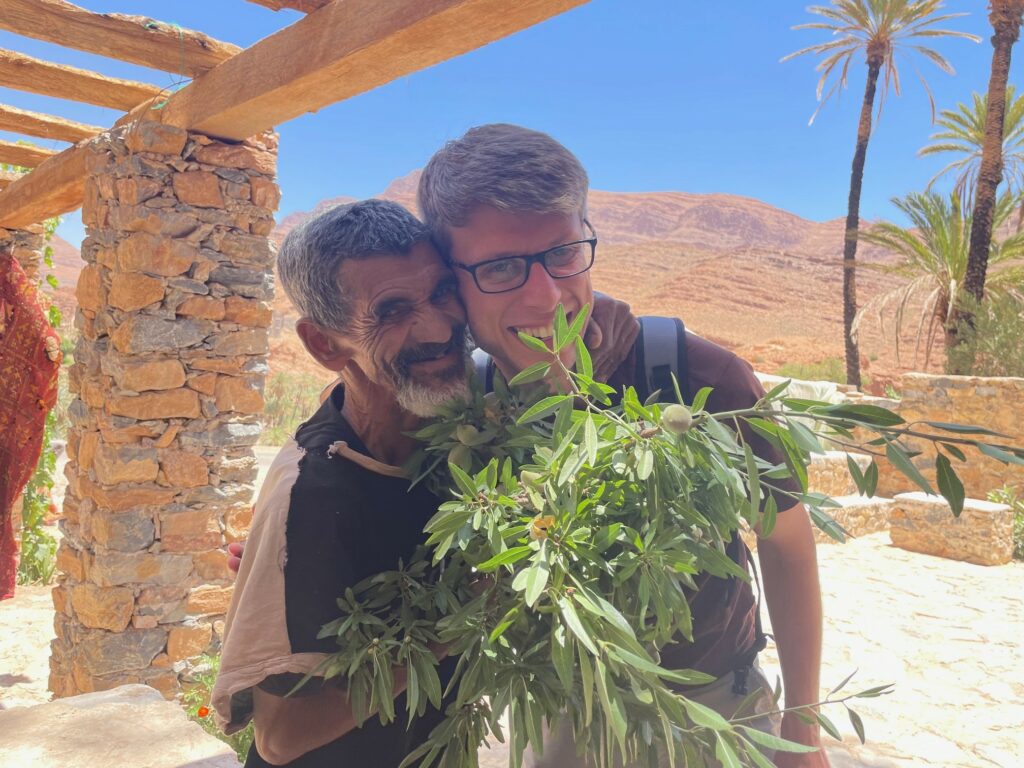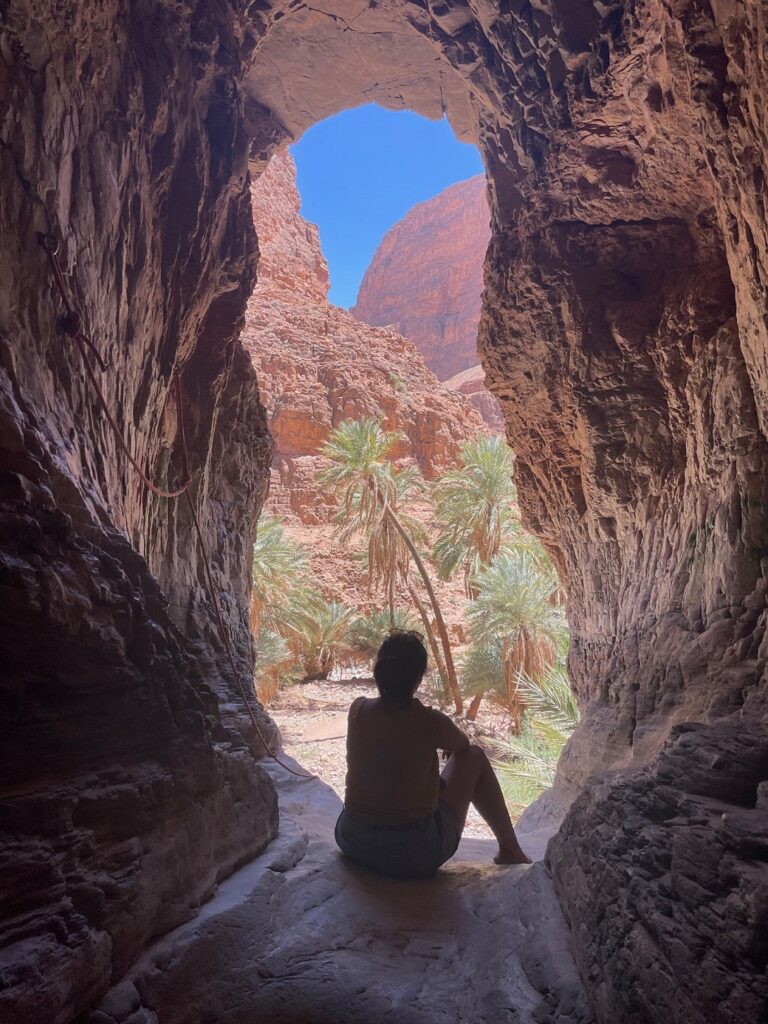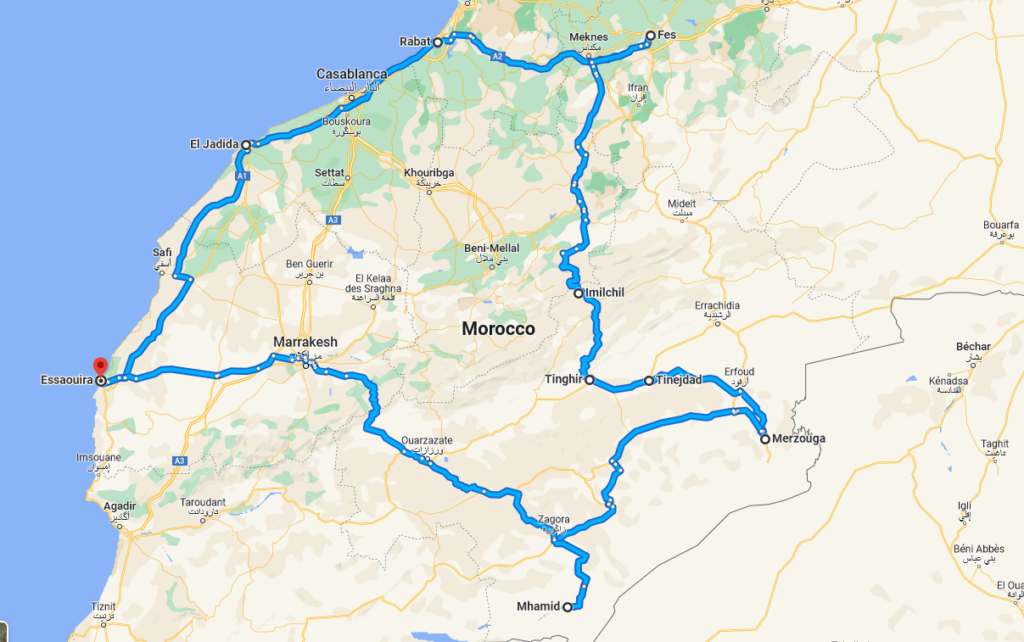As you are already in Morocco for our wedding, it would be a shame not to travel any further! Therefore some general travel tips, highlights and recommended accommodations.
Health
Some vaccinations are recommended when you visit Morocco: website.
That being said, if you don’t plan on mingling too much with the locals or local wildlife, health risks should be very limited, certainly if you’re up to date with the most important vaccinations.
Mobile internet
You can buy a SIM card in most airports or in small phone shops along the road. 20€ will give you 20 GB of data, which should be enough for your stay. Most providers have a good network, with mobile internet almost everywhere, except in the mountains. The providers we have used before, are INWI and Maroc Telecom.
Money and prices
As of September 2023, 1 Euro equals about 11 Moroccan Dirham (MAD). So if you divide the price in MAD by 10, you’re always on the safe side. You will find plenty of places to withdraw cash or exchange euros in the big cities, maybe a bit less in the countryside (don’t forget to activate your cards outside of Europe!).
Budgetwise, you should count on spending around 90-100€ per person per day. This includes car rental, hotels, food, drinks and visits.
A little note on Moroccan prices. As a tourist, people will sometimes try to take advantage by charging you too much for certain products. The following price list should help give you an idea:
- Traditional flatbread: 2 MAD
- Large bottle of water: 5 – 7 MAD
- Taxi fare: 6 – 9 MAD per km in the big cities (‘petits taxis’). You can check this website to give you an idea about bigger transfers. Always try to negotiate a price before you enter the car.
- Souvenirs: online you can read that you should haggle down to only 1/3 of the price. If you’re able to do this: congratulations. Tom is probably too touristy to achieve this, and is very glad if he gets the price down to about 2/3 🙂
On driving in Morocco
Everything written below assumes you will self-drive around the country. In our opinion, this is the best way to see and do as much as possible in Morocco, as it is quite a large country (almost as big as Spain, excluding the Western Sahara). On top of this, it is also a very nice country to self-drive, as roads in general are good, and traffic is light outside of the big cities (inside the cities, it’s… interesting). Combine this with the grandiose vistas along the way, and it’s perfect for a road trip!
If you’re wondering about car rental, check out the chapter ‘And other practical stuff’ on the RSVP tab.
Highlights & Recommended Accommodations
For all information, we heavily recommend ‘Le guide du Routard’. In Dutch, this would be ‘Trotter’, but in our experience the original French version is more interesting.
The following is a personal selection of highlights, but is by no means exhaustive. It’s certainly worthwhile doing research on other must-sees!
Shorter stay – up to a week

- Essaouira: Essaouira itself is well worth a visit: one of the most ‘European’ cities in Morocco, it has a vibrant medina, an agreeable port (with interesting fish market) and long sandy beaches, ideal for surfing.
- Accommodation:
- La Villa Sauvage
- Villa des Hauts Mogador
- Villa Beldi
- Dar Liouba: Inside the medina, a quiet and luxurious place away from the hustle and bustle in the streets around it.
- Accommodation:
- Marrakech: We tend to avoid Marrakech. While it certainly has lots of interesting stuff, it is also one of the few places in Morocco were we sometimes felt unsafe or bothered too much.
- Imi n’Ifri and the Ouzoud waterfalls (both near Demnate): On the way to the valley of Aït-Bougmez, you pass by the natural bridge of Imi n’Ifri. Well worth a stop. The Ouzoud waterfalls are ‘nearby’, but we haven’t had the chance of visiting them yet. Over 100 meters high, they’re supposed to be very pretty.
- Valley of Aït-Bougmez (the Happy Valley): High in the mountains (2000m), this valley offers some of the best of Morocco: welcoming people, majestic views and great hiking.
Note: if you travel from here to the Rose Valley, you will pass over the highest accessible mountain pass in Morocco, Tizi n’Ait Imi, at 3000m! The road turns into gravel for a few kilometers, but is very accessible.- Accommodation:
- Dar Si Hamou: Beautiful house with basic but correct rooms. Nice view from the rooftop terrace and tasty tajine in the evening.
- Accommodation:
- The Dadès Valley:
- The Rose Valley: Named after the roses which are harvested for rose water.
- The Dadès Gorges: Majestic canyon.
- Skoura: Well worth a stop for its palm grove and Kasbah Amridil (castle). We’ve met a very interesting Berber guide, Hassan, who can explain the history of the Kasbah and life in the palm grove very well.
- Accommodation:
- Dar Es Salaam: A little paradise on the edge of the palm grove. Very friendly people that set us up with Hassan the guide.
- Auberge Espace Kasbah Amridil
- Accommodation:
- Ouarzazate: Ouarzazate has been one of the main Hollywood destinations for scenic backgrounds for many years. So, while the town itself is not that interesting, a visit to the movie studios comes highly recommended, if only to walk around in some ‘authentic’ Egyptian temples!
- Ksar Ait-Benhaddou: Talking about Hollywood, Ksar Ait-Benhaddou has been the background in The Mummy, Gladiator, Prince of Persia, Game of Thrones and many others. (When we were there in June, everything was closed off for filming Gladiator 2.) When you’ll see it, you’ll understand why it’s so popular…
- Tizi-n-Tichka mountain pass: If you like driving through the mountains, we recommend the detour over Tizi-n-Tichka: one of the highest mountain passes (and very accessible, they’ve been widening the road), with stunning views.
- Accommodation:
- If you don’t want to stay in Marrakech: Aghmat Lodge. The area has nothing to offer, but the rooms are very comfy and the swimming pool enchanting. You can visit ‘Le jardin du safran’ nearby, one of the few places in Morocco where they cultivate saffron!
- Accommodation:
- Tizi-n-Test mountain pass: Normally we would also recommend this road through the High Atlas. However, it goes straight through the epicentre of the September earthquake. As such, we don’t know about conditions there, or whether tourists are even wanted there right now.
- Taroudant: We don’t like it.
- Tafraoute: In the middle of the Anti Atlas mountain range, this one is a bit out of the way, but comes highly recommended! The landscapes can be vast or claustrophobic, driving through sometimes alien landscapes. Going further south, you end up at the gate of the Sahara.
- Recommended in the area:
- Kasbah Tizourgane: An old Kasbah turned hotel, it looks like a medieval castle.
- Maison traditionelle in Oumesnat: An old house turned museum, it’s held open by the son of the late owner, passionate about the history of the house and his people.
- The Aït-Mansour Gorges: A beautiful palm tree oasis in between the arid rocks. Make sure to say hi to Omar from us at Café Omar (see picture below)!
- The really brave among you can continue further south, first passing by the village of Aoukerda and it’s magnificent canyon, then through an ever widening gorge (beautiful road!) until you reach the ‘gate of the Sahara’ in Icht: the high rocks turn into a flat, arid plain.
- Accommodation:
- El Malara: The French owner is peculiar, but very good rooms and even better restaurant.
- Recommended in the area:


Longer stay – more than a week

- El-Jadida: Interesting old town: an old Portuguese fortress that has been turned into a village within the town. Well worth a stop along the way.
- Casablanca: Even though it’s Morocco’s largest city, we haven’t really visited Casablanca yet. We did stop by for the splendid Hassan II mosque though. The largest mosque in Africa, it’s a must-see if you come this way.
- Rabat: Morocco’s capital has pretty old town which merits a detour by itself. Nearby you can also find the necropolis of Chellah: an old Roman city turned graveyard, in ruins since an earthquake in 1755, the atmospheric setting is enhanced by the clattering beaks of the resident storks!
- Meknès: An old imperial city with lots of history. We last visited back in 2010 (we weren’t even a couple then), so the only thing we remember is a large underground prison…
- Volubilis: Magnificently preserved Roman city, which was left mosty intact until an 18th century earthquake. Fellow archeology enthusiasts, unite!
- Fès: If you’ve come this far, the imperial city of Fès is absolutely incontournable! And we do not only say this because Wafa’s family originates from here!
The old town/medina is, in our opinion, one of the most authentic urban sites of Morocco (much more than its counterpart in Marrakech, for example). Home to palaces, riads & museums, markets & souks, donkeys & monkeys, shops, artisans & tanneries, it can be an exhilirating experience. In recent years, they’ve been disneyfying parts of the medina, so go see it now!
Warning: not for the agoraphobic (45000 people per square km), claustrophobic (tight and winding alleys), osmophobic (can be really smelly, especially the tanneries) or those that get lost easily! It’s completely normal to spend a few days inside the medina and still not find your own way… Also: pay attention to pickpockets!- Accommodation:
- On previous occasions, we mostly stayed in the house of Wafa’s grandma, on the edge of the Medina, so we haven’t got that many adresses yet.
- R’Mila Medina Fez: One that we liked (and was very affordable). Near the house of Lala, it offers a good starting point to explore the rest of the old town.
- Accommodation:
- Imilchil: Going back south, you pass the village of Imilchil. While we haven’t been there yet, it’s supposed to be a paradise for hikers. Also famous for the moussem: in a village nearby this Moroccan speed dating event takes place in August, and is one of the few events in Morocco that allows boys and girls to meet each other freely (officially).
- Tineghir, the Todgha Gorges and Tinejdad: We haven’t been here either, but Tineghir (palm grove), the Todgha Gorges (beautiful views) and Tinejdad (museums) are all worthwhile stops, it seems.
- See above: The Dadès Gorges
- Merzouga: If you’ve come this far inland, you’re here for one thing: the desert! Merzouga is famous for the erg Chebbi: a colossal sand dune (150 square kms) that towers over the surrounding landscape.
- Zagora: The last city before the desert, Zagora is an agreeable town thanks to its large palm grove, which you can visit easily.
- Accommodation
- Riad Dar Zaouia: absolutely delightful host. We even had the opportunity to visit the old family home inside the palm grove, where he told us about the history of the palm grove and life inside it.
- Recommended in the area:
- Ksar de Tissergate: Prime example of a (restored) traditional fortified town in this area.
- Tamegroute: For those of you that want their own authentic Moroccan pottery! If not, there is also an old library well worth a visit.
- Mhamid: Another desert town that lies at the edge of the Sahara. It’s a starting ground for excursions deeper into the desert, which makes it less accessible than Merzouga.
- Accommodation
- See above: Ouarzazate, Skoura, Ksar Ait-Benhaddou, Tizi-n-Tichka
